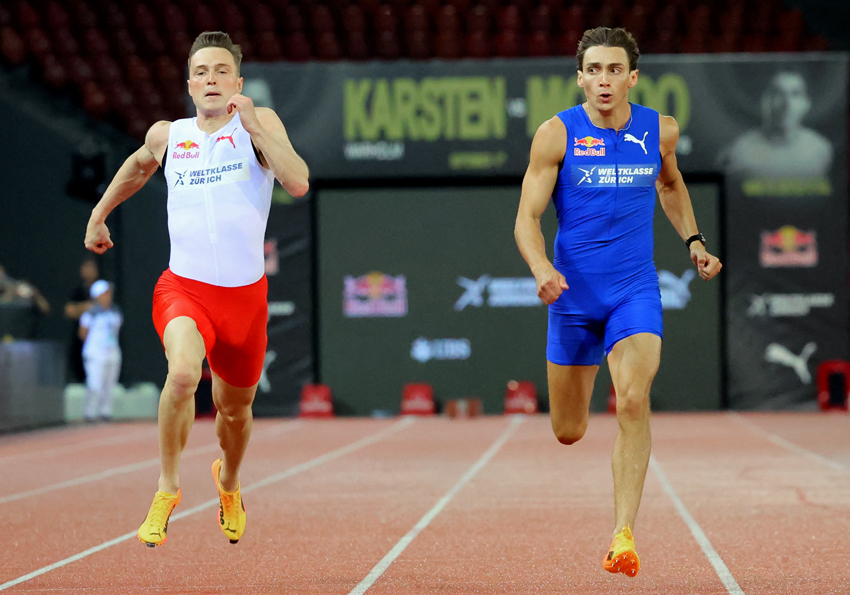Eating disorders, bone loss and menstrual irregularity- the female athlete triad
But an important new US study has revealed that the combination of eating and menstrual problems is no more detrimental to bone than either problem alone.
The subjects of this study were 91 competitive female distance runners aged 18-26. Disordered eating was assessed via the Eating Disorders Inventory (EDI), which measures attitudes to food and body size, menstrual irregularity was defined as anything from 0-9 periods a year, while bone mineral density (BMD) was measured by a technique called dual x-ray absorptiometry.
Key findings were as follows:
- An elevated score on the EDI (highest quartile) was independently associated with oligomenorrhea (irregular periods) and amenorrhea (absent periods);
- Oligo/amenorrheic women had lower BMD than normally menstruating runners at the spine (-5%), hip (-6%) and whole body (-3%);
- Normally menstruating runners with elevated EDI scores had lower BMD than those with normal EDI scores at the spine (-11%), hip (-5%) and whole body (-5%);
- Runners with a combination of oligo/amenorrhea and elevated EDI scores had no further reduction in BMD than those with only one of these risk factors.
A particularly interesting aspect of their findings was that, while the women with elevated EDI scores reported lower total energy intakes and lower percentage fat intakes than those with normal EDI scores, they tended to be heavier.
The researchers comment: ‘We would expect women with subclinical eating disorders to have lower weight and body fat, but this was not the case in our study. Possibly, heavier women are more prone to eating disorders because they are more dissatisfied with their natural body type.’
They speculate that some of the athletes with higher EDI scores might have had bulimic (binge-and-vomit) tendencies, which are less likely to produce weight loss than anorexia. Alternatively, the EDI scale may identify women in the early stages of an eating disorder but may miss women in the later stages, who have already lost weight. Or some of the thinnest women – those with menstrual problems but low EDI scores – may have been in denial about their eating problems.
Whatever the reason, the worrying conclusion is that the female athlete triad may be more of a hidden problem than has previously been appreciated, and not readily discernible by a doctor or coach.
The researchers conclude: ‘Because there is a high prevalence of [bone deficiency] in this population that may have serious life-long consequences, we recommend that all competitive women endurance athletes… receive screening for eating disorders and menstrual irregularity and education about the female athlete trial.’
Med Sci Sports Exerc, vol 35, no 5, pp711-719, 2003
You need to be logged in to continue reading.
Please register for limited access or take a 30-day risk-free trial of Sports Performance Bulletin to experience the full benefits of a subscription. TAKE A RISK-FREE TRIAL
TAKE A RISK-FREE TRIAL
Newsletter Sign Up
Testimonials
Dr. Alexandra Fandetti-Robin, Back & Body Chiropractic
Elspeth Cowell MSCh DpodM SRCh HCPC reg
William Hunter, Nuffield Health
Newsletter Sign Up
Coaches Testimonials
Dr. Alexandra Fandetti-Robin, Back & Body Chiropractic
Elspeth Cowell MSCh DpodM SRCh HCPC reg
William Hunter, Nuffield Health
Keep up with latest sports science research and apply it to maximize performance
Today you have the chance to join a group of athletes, and sports coaches/trainers who all have something special in common...
They use the latest research to improve performance for themselves and their clients - both athletes and sports teams - with help from global specialists in the fields of sports science, sports medicine and sports psychology.
They do this by reading Sports Performance Bulletin, an easy-to-digest but serious-minded journal dedicated to high performance sports. SPB offers a wealth of information and insight into the latest research, in an easily-accessible and understood format, along with a wealth of practical recommendations.
*includes 3 coaching manuals
Get Inspired
All the latest techniques and approaches
Sports Performance Bulletin helps dedicated endurance athletes improve their performance. Sense-checking the latest sports science research, and sourcing evidence and case studies to support findings, Sports Performance Bulletin turns proven insights into easily digestible practical advice. Supporting athletes, coaches and professionals who wish to ensure their guidance and programmes are kept right up to date and based on credible science.









